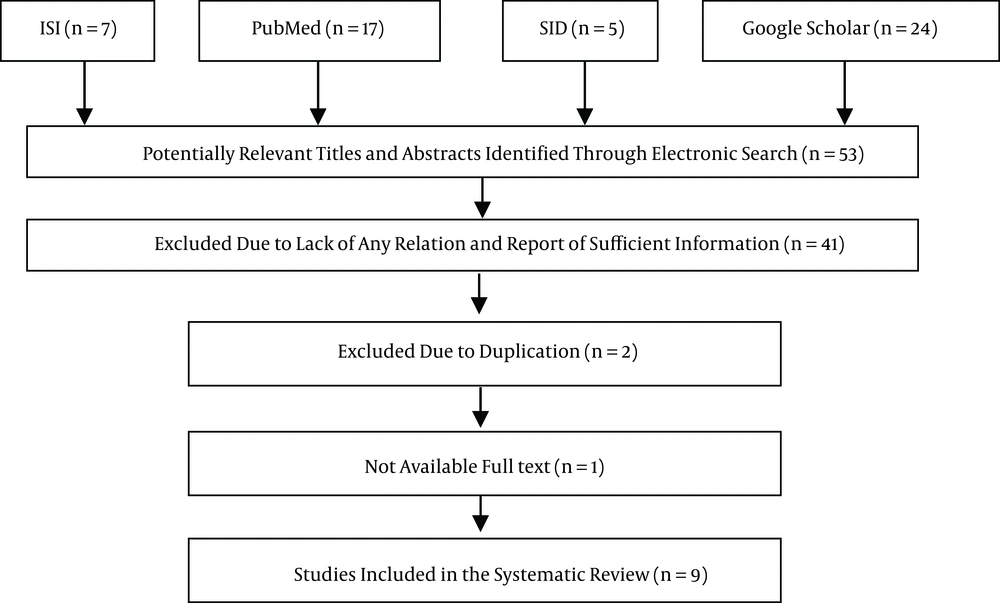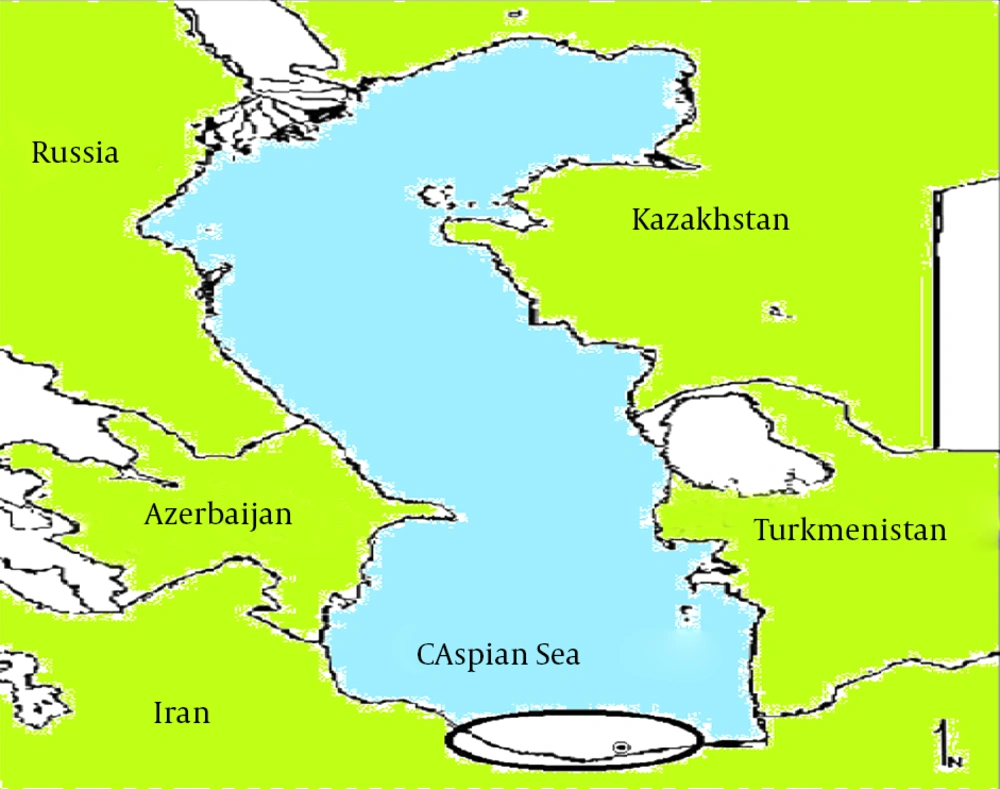1. Context
1.1. Caspian Sea
The Caspian sea (CS) with a volume and surface area of 78000 km3 and 380000 km2, respectively, is the biggest land body of water in the world and a unique system that is surrounded by five countries: Iran (900 km), Azerbaijan, Turkmenistan, Kazakhstan and Russia (1). The Caspian sea has about 130 river inputs, but no output (1-3). Various pollutants have accumulated in the Caspian sea due to many human activity sewages, agricultural and industrial waste flowing into the landlocked system, which threaten directly or indirectly environment and human health especially through the food chain (4, 5).
1.2. Organochlorinated Pesticide
The use of pesticides and fertilizers has been substantially increased to increase additional production of crops around the world as a consequence of increased human population (6-8). In spite of the potential to prevent and control insects, disease vector and weed, some pesticides such as Organochlorine pesticides (OCs) can be toxic to human health, wildlife and have deleterious impacts on the environment (9, 10). There is strong evidence on the association with a wide range of diseases and exposure to pesticides (11). Exposure to organochlorine pesticides may result in health-related complications including reproductive defects (12, 13), carcinogenic effects (14) breast cancer risk (15) and behavioral changes (16). Organochlorinated pesticides are chlorinated hydrocarbons that are composed primarily of carbon, hydrogen and several chlorine atoms per molecule (16, 17). Due to their hydrophobic characteristics, resistance to degradation, toxicity, least solubility in water, bioaccumulative nature, low vapour pressures and long-range transport and trans-boundary dispersion, the control of OCs in the environment is a real necessity (6, 17-19). Some of the most representative compounds in this group are the Dichlorodiphenyltrichloroethane (DDT) and its analogues, isomers of Benzene Hexachloride (BHC), heptachlor, chlordane, aldrin, mirex, chlordecone, toxaphene and some isomers of Hexachlorocyclohexane (HCH), such lindane (17). Organochlorine pesticides break down slowly in the environment and bioaccumulate in the food chain such as fish tissues (16, 20). The objective of the present study was to conduct a systematic review of the available literature to assess the toxicological data and to give an integrated illustration of the concentrations of organochlorine compounds in Caspian Sea fishes.
2. Evidence Acquisition
2.1. Study Identification and Selection
2.1.1. Study Identification
All titles or abstracts of publications in English and Persian language were screened by a search of four Internet databases (PubMed, ISI, SID, and Google Scholar) from 1999 to 2012, to identify suitable articles. Various combinations of the following key phrases were used: Caspian Sea, organochlorinated pesticide, fish, environmental toxicology.
2.1.2. Study Selection
A study was considered for further review if 1, it referred to organochlorinated pesticide residues in Caspian Sea fishes; 2, and if the publication presented original Data. A publication was excluded if it had the following criteria: non-English or non-Persian language publication, book chapters and published articles that reported pesticide contamination in animals except fish; these items were unavoidable limitations in our study.
2.2. Data Extraction
The following data on the study characteristics were derived from each included study: the first author's last name, publication year, geographic location, type of fishes and pollutant studied.
No modification of original data was done. The basic characteristics of outcome data from eligible studies in this review are reported in Table 1.
3. Results
3.1. Description of Studies
The electronic searches identified a total of 53 articles, 41 were excluded after title and abstract screening due to lack of relationship and report of sufficient information. Two articles were duplicates; one was excluded for inavailability of full text. Figure 1 describes a flow- diagram for the articles screening procedure.
| Reference | Geographic Location | Type of Fishes | Pollutant Studied |
|---|---|---|---|
| Kajiwara et al. (2003) | Kazakhstan, Azerbaijan, Turkmenistan and Iran | Beluga, Russian Sturgeon, Stellate Sturgeon, Persian Sturgeon, Ship Sturgeon | PCBs, DDTs, CHLs HCHs, HCB,HP epox, Dieldrin TCPMOH |
| Kajiwara et al. (2008) | Kazakhstan, Azerbaijan, Turkmenistan, and Iran | Caspian Roach, Monkey Goby, Round Goby, Caspian Sprat, Anchovy Sprat, Caspian Sandsmelt | PCBs, DDTs, HCHs CHLs, HP epox, HCB, TCPMOH, TCPMe |
| Shokrzadeh et al. (2006) | Iran | Sefid, Kilca, Koli, Kafal | Chlorobenzilate |
| Keshavarzi fard et al. (2008) | Iran | Stellate Sturgeon | Lindane, Heptachlor, Dieldrin, Aldrin and DDT |
| Vaezzadeh et al. (2008) | Iran | Cyprinus Carpio, Rutilus Frisii | lindane, heptachlor, aldrin, dieldrin and DDT |
| Shokrzadeh lamuki et al. (2012) | Iran | Rutilus Frisikutum, Clupeonella Delicatula,Mugila Auratus, Vimba Vimba | D.D.T, D.D.A |
| Tanabe et al. (2003) | Kazakhstan | Abramis Brama Rutilus sp. | DDT,PCBs, HCHs, CHLs, TCPMe, and TCPMOH |
| Watanabe et al. (1999) | Russia | Rutilus sp. | PCBs, DDTs, HCHs, CHLs, and HCB, |
| Ebadi et al. (2006) | Iran | Koli, Kafal, Sefid, Kilca | lindane |
Basic Characteristics of Included Studies
3.2. Outcomes
In total, the nine remaining articles met the inclusion criteria and our main focus was on these studies (5, 21-28). Various pesticides were evaluated in each study. The details of pollution levels in fishes for each of the nine included papers are presented in Table 2. As can be seen from Figure 2, the study areas are shown in green color.
| Reference Unite | DDTs | PCBs | CHLs | HCHs | HCB | Dieldrin | TCPMOH | Heptachlor Epoxide | γ-HCH | Chlorobenzilate | Linden | Aldrin | TCPMe |
|---|---|---|---|---|---|---|---|---|---|---|---|---|---|
| Kajiwara et al. (2003) ng/g | 73 - 31,000 ng/g | 70 - 7400 ng/g | 5.2 - 360 ng/g | 16 - 99 µg/g | 3.0 - 71 ng/g | 2.0 - 23 ng/g | 0.62 - 36 ng/g | 0.75 - 4.7 ng/g | - | - | - | - | Was below the detection limit |
| Kajiwara et al. (2008) | 3.1 - 560 µg/g | 1.5 - 320 µg/g | 0.057 - 14 µg/g | 0.11 - 17 µg/g | 1.2 - 160 ng/g | - | 7.3 - 9900 ng/g | 11 - 2600 ng/g | Was below the detection limit | - | - | - | 1.0 - 950 ng/g |
| Shokrzadeh et al. (2006) | - | - | - | - | - | - | - | - | - | 0.017 - 0.038 ppm | - | - | - |
| keshavarzi fard et al. (2008) | 0.57 mg/kg | - | - | - | - | 0.037 mg/kg | - | 3.9 mg/kg | - | - | 0.069 mg/kg | < 0.029 mg/kg | - |
| Vaezzadeh et al. (2008) | 0.1014 - 0.7522 mg/kg | - | - | - | - | 0.0444 - 0.5248 mg/kg | - | 4.2448 - 1.051 mg/kg | - | - | < 0.037 - 0.0872 mg/kg | < 0.0356 - 0.037 mg/kg | - |
| Shokrzadeh lamuki et al. (2012) | 0.019 - 0.031 mg/kg | - | - | - | - | - | - | - | - | - | - | - | - |
| Tanabe et al. (2003) | 780 - 24,000ng/g | 950 - 7,700ng/g | 41 - 490 ng/g | 110 – 950 ng/g | 2.0 - 18 ng/g | - | 7.7 - 82 ng/g | - | - | - | - | - | 1.5 - 13 ng/g |
| Watanabe et al. (1999) | 0.017 - 0.024 μg/g | 0.033 μg/g | 0.0016 - 0.0008 μg/g | 0.010 - 0.0037 μg/g | 0.0016 - 0.0005 μg/g | - | - | - | - | - | - | - | - |
| Ebadi et al. (2006) | - | - | - | - | - | - | - | - | - | - | 5.51 - 49.57 g/kg | - | - |
Summary of Organochlorinated Pesticide Concentration in Eligible Studies
4. Conclusions
A few studies or reviews have been published in databases about pesticide residues in Caspian Sea fish tissues. All these studies reported that there was clear evidence of organochlorinated compounds in all examined fishes collected from the Caspian sea. Table 3 presents the outcome of the DDT pesticide contamination levels in different years. The studies ranged according to the time of sample collection from 1993 to 2008. Compilation of available data from surveys indicates a downward trend of contamination. The DDT levels in samples collected showed a rapid decline during 1993 to 2008. Details from each study are summarized in Table 3. This result suggests a sign of extensive usage of organochlorinated compounds in the past, around the Caspian Sea region. In 1969, the usage of DDT was banned in the former Soviet Union, which may be an explanation for the slow decline of DDT. Maximum residue limit (MRL) established by food and agriculture organization of the United States (FAO)/world health organization (WHO) and acceptable daily intake (ADI) for five pesticides are summarized in Table 4. For example this study shows that the concentration of DDT in most studies exceeded the MRL value. Concentrations of DDT in studies of Vaezzadeh et al. (25) and Shokrzadeh lamuki et al. (23) on lipid weight basis were found to be less than the standard value.
| Reference | Date of Sampling | DDT Concentrations |
|---|---|---|
| Watanabe et al. (1999) | 1993 | DDT (5600-88000) |
| Tanabe et al. (2003) | 1992 - 1993 - 1995 - 1998 | DDT(1993 = 25000); DDT (1998 = 9200) |
| Kajiwara et al. (2008) | 2000 - 2001 | DDT (3100 - 560000) |
| Kajiwara et al. (2003) | 2001 - 2002 | DDT (73 - 31000) |
| Ebadi et al. (2006) | 2004 | - |
| Shokrzadeh et al. (2006) | 2004 | - |
| Vaezzadeh et al. (2008) | 2006 | DDT(321) |
| Shokrzadeh Lamuki et al. (2012) | 2008 | DDT (33) |
| Keshavarzi Fard et al. (2008) | - | - |
Organochlorine Concentrations (ng/g on lipid weight) in Fish Tissues Collected From the Caspian Sea
| Reference Unite | DDT | Dieldrin | Aldrin | heptachlor | Linden |
|---|---|---|---|---|---|
| MRL, (mg/kg lipid weight) | 1 | 0.2 | 0.2 | 0.15 - 0.2 | 2 |
| ADI, (mg/kg b.w.) | 0 - 0.02 | 0 - 0.0001 | 0 - 0.0001 | 0 - 0.0005 | 0 - 0.008 |
Maximum Residue Limit (MRL) and Acceptable Daily Intake (ADI) for Five Organochlorinated Pesticides
5. Conclusion
To the best of our knowledge, this is the first review paper of OC contamination in Caspian fishes. Although a number of comprehensive studies dealing with OC contamination in other lakes have been conducted recently, investigations in Caspian Sea are limited. This review summarizes reported contamination levels in fish of the Caspian Sea and suggests that organochlorinated compounds exist in various fish samples in Caspian Sea areas. The residue pattern was in the order of DDT > Heptachlor > PCBs > Linden. Additionally, the available data indicate the average concentration of organochlorinated compounds to be less than the Maximum Residue Limit in recent studies. Although contamination level was relatively low, the present status might pose a risk for accumulation of OC in the food web and effects human health and wildlife.

